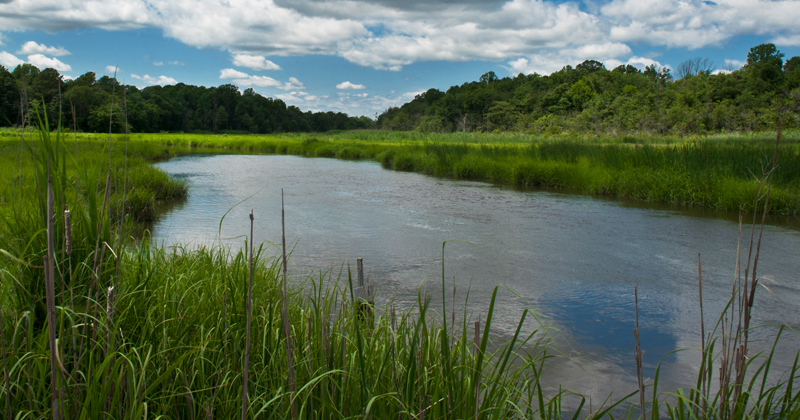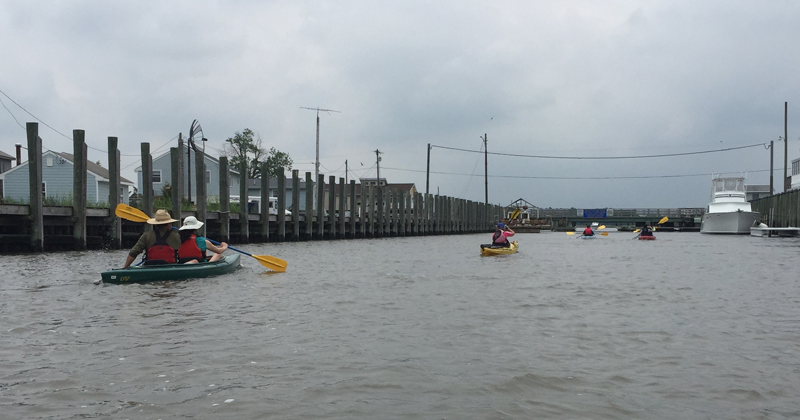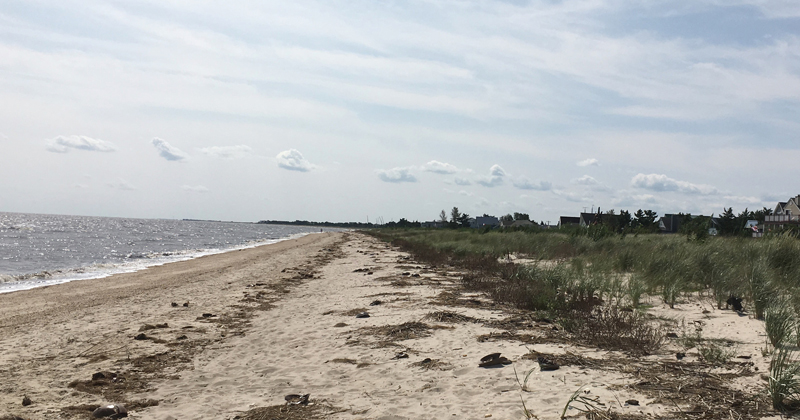


Ecotourism and resiliency planning
Photos by Karen Roberts, Lisa Tossey and Tony Pratt June 22, 2023
Delaware Sea Grant helps put together ecotourism and resilience investment strategy for Milford, Slaughter Beach
Southern Delaware is home to some incredible natural resources. While most Delawareans and tourists who flock to this part of the state in the summer know of the beaches, a bit farther north there are two towns — Milford and Slaughter Beach — that are home to extremely valuable and biodiverse natural resources that might sometimes get overlooked.
The Mispillion River, for instance, runs through Milford before ending at Slaughter Beach. Slaughter Beach has the Delaware Bay, the beach, Cedar Creek as well as marsh habitat. These areas have tremendous value and both communities have depended on the natural resources, in one way or another, for their economic well-being, culture and heritage for decades.
With the threat of sea level rise, climate change bringing stronger and more frequent storms, and land-use development that is starting to move up from the coast, if the communities don’t start to think about how to protect and sustain these natural resources going forward, they are at risk.
A new report from a coalition known as the Waterways Infrastructure & Investment Network (WIIN) is looking to raise the profile of these two towns while also helping to keep the communities resilient to coastal hazards.
WIIN released an “Ecotourism and Resilience Investment Strategy for the Mispillion and Cedar Creek Watersheds,” which details how ecotourism and other nature-based investments can sustain and enhance benefits to this region for generations to come. The strategy re-brands the Mispillion River as “Delaware’s Hidden River” awaiting to be discovered and celebrates Cedar Creek as “naturally pristine.”

The report is the culmination of a two-and-a-half-year effort, funded by a grant from the National Coastal Resilience Fund. WIIN had previously released an economic assessment of the two watersheds’ environmental resources that detailed their monetary value to the communities.
WIIN was formed by members of the Delaware Resilient and Sustainable Communities League (RASCL), including Delaware Sea Grant (DESG), the project manager; the University of Maryland Environmental Finance Center, the author of the economic study and investment strategy; and the Partnership for the Delaware Estuary (PDE), the project's administrative and fiscal agent, who also developed a vulnerability assessment tool for the coalition.
Together with the City of Milford, the Town of Slaughter Beach and The Pew Charitable Trusts, they succeeded in competing nationally for a $220,000 grant from the National Coastal Resilience Fund.
Danielle Swallow, Coastal Hazards Specialist for DESG who led the effort for DESG with WIIN, said each town had a limited capacity to undertake some of the necessary planning that would improve their resilience to climate hazards. WIIN was formed, in part, to help these towns apply for a federal grant.
“We saw the potential to help these two towns go after federal resilience funding,” said Swallow. “The grant we applied for is really competitive. Communities all over the country like Miami, Florida, and Portland, Oregon, were competing for it. So to go up against these big towns, we felt like we had to help these [Delaware] towns out by bringing in partners, raising match dollars and developing a regional approach.”
WIIN was able to support the towns in obtaining the highly competitive grant and also to help them prioritize resilience planning.
“Milford and Slaughter Beach were ready, willing and able to do that but they needed the extra capacity that we brought,” said Swallow. “The result is we came out with the economic study that showed that their resources contribute millions of dollars just in leisure and recreational value alone. We also came out with the investment strategy, which is a collection of ideas from the community that basically centers the natural resources in the economic strategies of these towns.”
Both towns have a rich historical relationship with their natural resources.
For decades, Milford served as a ship building mecca for the state. Ships built in town would then float down the Mispillion on their way to the bay. There is still a shipyard in town that Milford is looking to preserve.
“The Mispillion River runs right through our city. It was always an important part of our downtown and maritime heritage,” said Archie Campbell, Milford’s mayor. “Now, we have a better understanding of its value and how it contributes to our quality of life.”

With Slaughter Beach, the connection to natural resources is through the fishing industry, and it is also home to an abundance of wildlife.
The horseshoe crabs come to Slaughter Beach to spawn and then the red knots fly in and feed off their eggs.
“There is a rich interaction going on between wildlife that supports a vibrant ecosystem,” said Swallow, who recently received her certification as a Climate Change Professional by the Association of Climate Change Officers. “The town has over the generations developed a real stewardship ethic and they are a certified wildlife habitat. They are a horseshoe crab sanctuary and there are a lot of volunteers who work to protect those crabs and the various birds.”
While both have a rich maritime history, they are also both vulnerable to sea-level rise and more extreme coastal storms; the latter will expose them to an increase in rainfall, overwhelming the rivers and creeks and causing inundation to roads and property.
Milford has had some high-profile floods along the Mispillion, which is home to their commercial center with storefronts and restaurants right around the banks of the Mispillion. When the river floods, those stores are vulnerable. Slaughter Beach floods a bit more regularly and with only two roads in and out of town, when they flood, it causes a public safety issue for members of the town.
With this strategy from WIIN, the goal is to both raise the profile of these natural resources so that people recognize them as resources worth sustaining, as well as attract investments that promote a balance between economic opportunity, sustainability and resilience.
“I like that this plan recognizes that the natural resources in Slaughter Beach are too important not to protect. It is about balancing economic opportunity with conservation and finding ways to be more resilient so that everyone gains,” said Bob Wood, Mayor of Slaughter Beach. “This effort is a game changer for us.”
Swallow said that a balance between economic opportunity, sustainability and resilience can be found in the area of ecotourism.
“Milford is really interested in growing the size of their community. They want to attract more visitors, more businesses and more residents. Slaughter Beach is fine staying the size that they are but they are open to having more visitors come through in a passive way,” said Swallow. “The more that people are utilizing these resources for ecotourism or leisure, the more the towns can advocate to federal and state authorities that this is contributing to the economy and to Delaware’s own culture and it’s worth investing in.”
In addition, Swallow noted that even though this phase of the grant project is over, it has already generated follow-up activities and initiatives. WIIN is still there to support the towns in their efforts and encourage them to implement some of the ideas that came about through the project.
The two towns have partnered on a grant proposal for a continuous bike path between the two towns. Also, the Coastal Resilience Design Studio, a partnership between the Delaware Sea Grant College Program, the University of Delaware Sustainable Coastal Communities Initiative, and the University of Delaware Landscape Architecture Program, is going to work with Slaughter Beach this summer on a comprehensive resilience planning project.
“We feel all of these things have come together to generate a lot of momentum for the two towns,” said Swallow. “It’s exciting because we’re already starting to see some of the fruits of that labor play out.”
Other WIIN coalition partners include Southern Delaware Tourism, the Nature Conservancy, Delaware Nature Society, Delaware Department of Natural Resources and Environmental Control, Sussex County, Kent County, I.G. Burton, David Burton and Tony Pratt. The branding and marketing strategy was developed by Ben Muldrow of Arnett, Muldrow, LLC.
Contact Us
Have a UDaily story idea?
Contact us at ocm@udel.edu
Members of the press
Contact us at 302-831-NEWS or visit the Media Relations website

